Work with AI
- English
- 中文
- 日本語
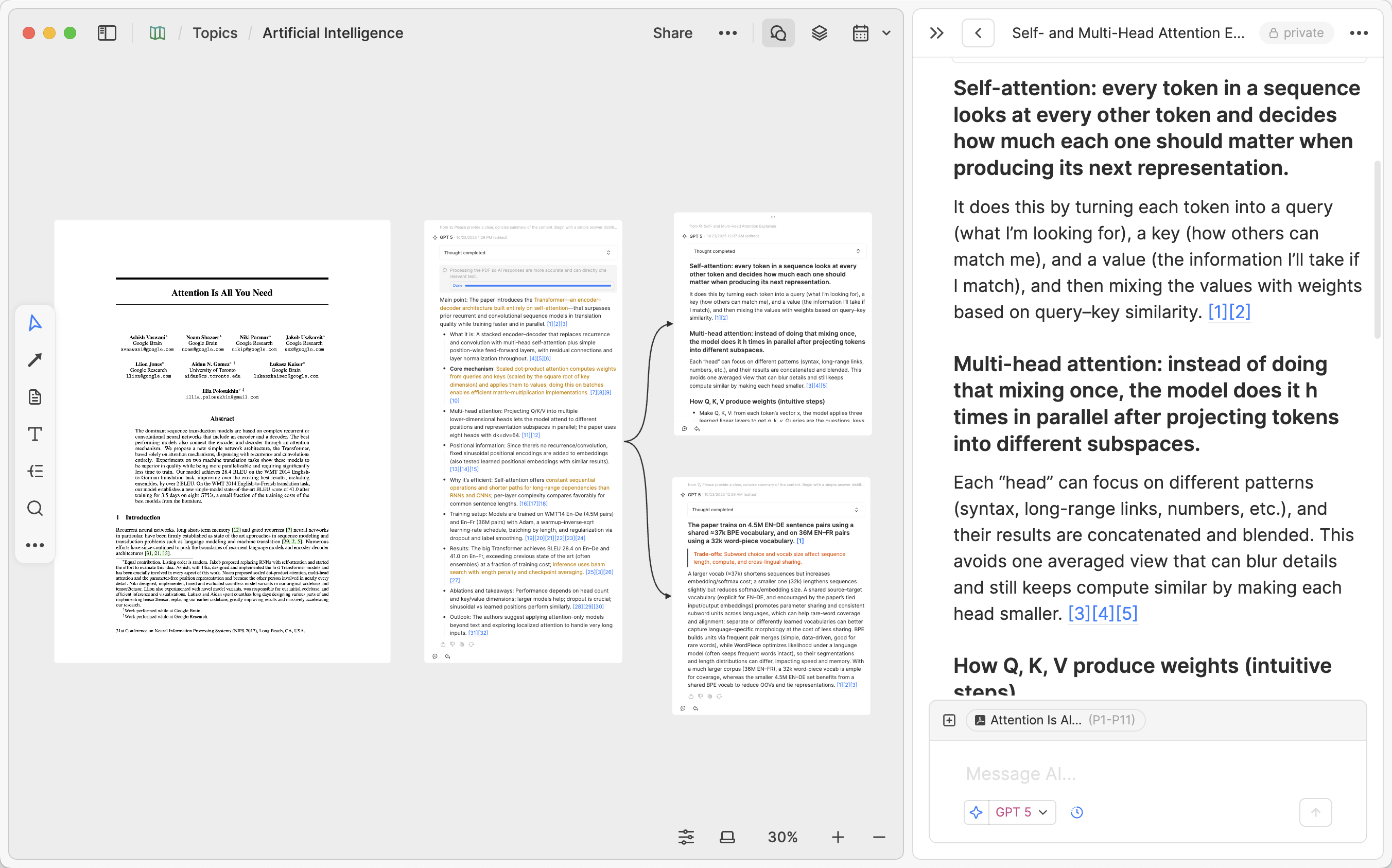
TL;DR
In Heptabase, you can open Chat on a whiteboard to chat with the latest AI models. By adding cards, sections, whiteboards, or content like PDFs, videos, and journals to the chat context, you enable AI to respond based on the content you select. You can also edit and annotate important messages before placing them back on the whiteboard, where they can be visually organized alongside your existing notes for centralized management of topic-related discussions. By working with AI, you can transform linear chat records into a more complete knowledge structure, continuously building deeper understanding of knowledge topics.
Introduction
In the AI era, people use prominent AI apps like ChatGPT, Google Gemini, and Claude to learn and research topics they care about. However:
When topics are complex and involve connections between many different concepts, you may wish to extract key knowledge points provided by AI from linear conversation threads and place them on a large whiteboard for easier research and review.
When you ask AI questions, you may want AI to read notes you've previously written or saved knowledge content, and provide valuable responses based on this content.
These are exactly what Heptabase's AI features excel at. In this article, I'll walk you through methods for using AI in Heptabase to accelerate learning and research, and share common use cases and workflows for different types of knowledge sources.
Overview
Generally, collaborating with AI in Heptabase includes the following core actions:
Open Chat in a topic whiteboard to centrally manage conversations related to that topic.
Use the add button "+" or "@" mention to provide the whiteboard and specific content to AI as context.
Right-click on PDFs, videos, journals, and cards on the whiteboard to add them to Chat, and have conversations based on these sources.
Drag valuable messages to the whiteboard or copy them to cards for editing and adding your own annotations.
Use sections, sub-whiteboards, or arrows to gradually integrate AI-assisted understanding into your knowledge graph.
Chatting with Whiteboards
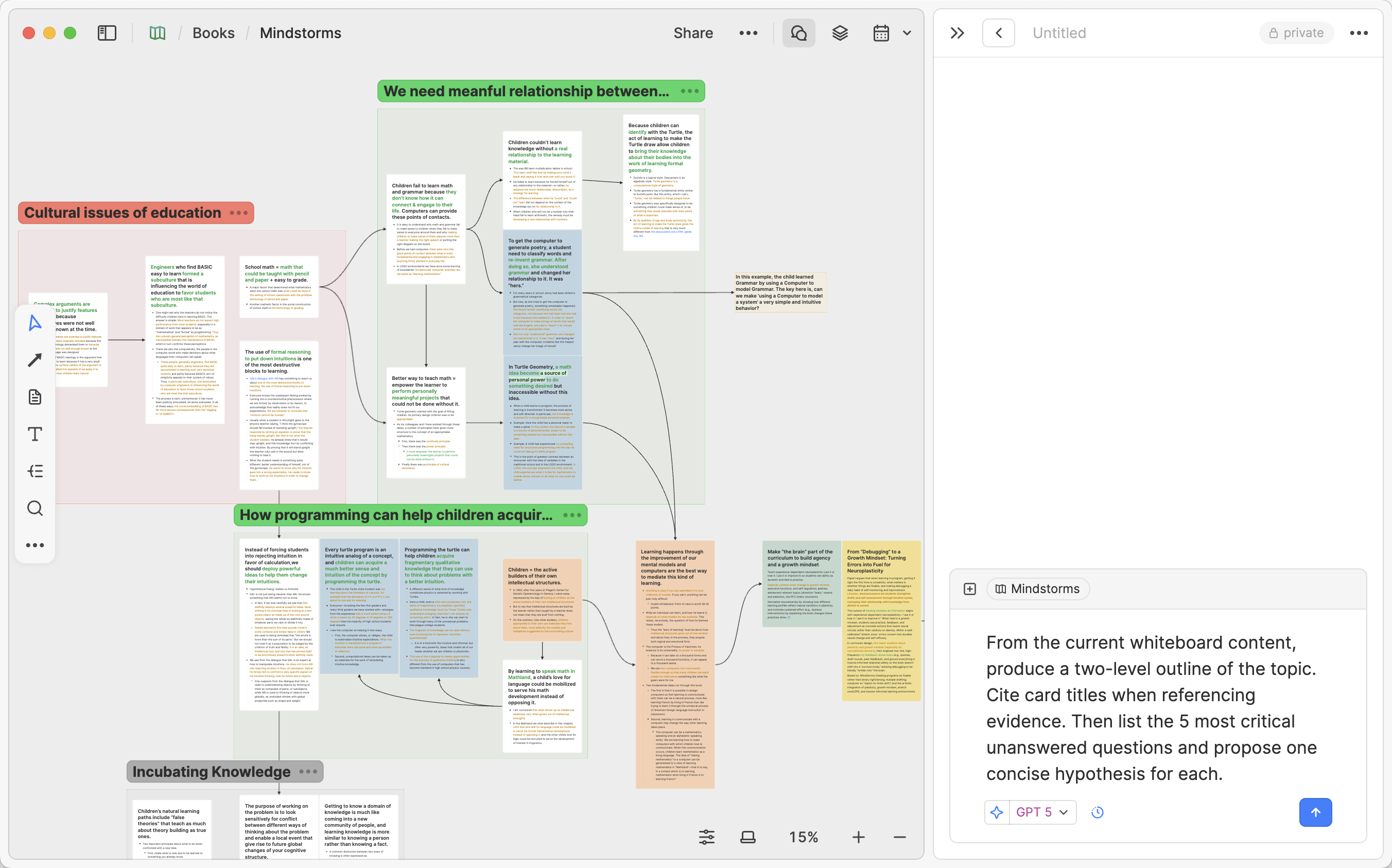
In Heptabase, each whiteboard represents a topic you care about. When you open a whiteboard, you can click Chat in the upper right corner to view chats related to this whiteboard. In each chat, you can not only discuss with other collaborators on this whiteboard, but also enable AI mode to converse with the latest AI models from tech companies like OpenAI, Google, Anthropic, and xAI.
Whiteboards serve three main purposes for AI conversations:
Thinking tool: When you want to better organize messages from AI, you can directly drag messages you find valuable onto the whiteboard for visualization. As accumulated chats and messages grow, you can use these messages as a foundation to build deeper, more comprehensive understanding of the topic on the whiteboard.
Topic-based folder: You can centralize AI chats related to a specific topic on the same whiteboard for easy future reference.
Knowledge context: You can add the entire whiteboard to the context of your AI chats, allowing AI to answer your questions based on the whiteboard's content. For example, you can add all journals from the past six months to a whiteboard with one click, ask AI to read them and then ask about things you don't know about yourself, or ask for advice based on these journals; or put multiple PDF files and YouTube videos on a whiteboard, letting AI answer your questions based on them.
Specifically, you can follow these steps to start an AI chat:
Open a topic whiteboard, click Chat in the upper right corner, where the default mode is AI Chat.
Select an AI model and context in Chat, enter your question and start the conversation.
Drag messages you find valuable onto the whiteboard and develop more understanding of the topic based on this information.
Providing Context to AI: Add Button and "@" Mention
Adding context is one of the features that allows AI to deliver maximum value. Both of the following methods enable AI to read your specified content before answering your questions:
Add button: Click "+" in the upper left corner of the chat box to add specific cards or an entire whiteboard to the context.
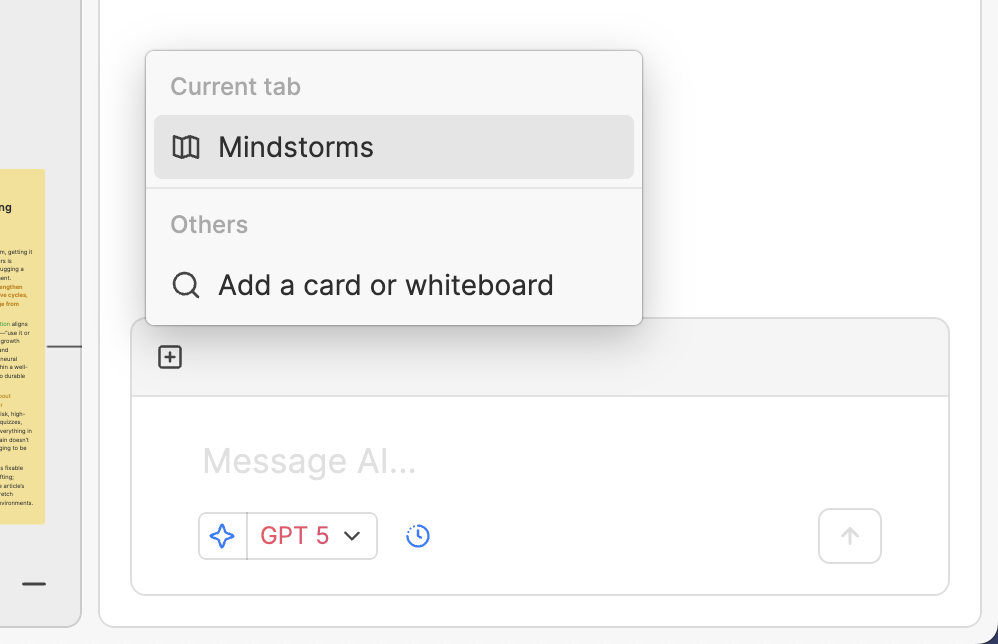
@ Mention: Type "@" in a message, search for and select the card, section, or whiteboard you want as context to make it a key reference. This method is suitable for quickly finding specific materials.

Chatting with PDFs
If your learning and research sources are often PDF files (for example: academic workers doing literature reviews, product managers reading industry reports, students reading reference books), through Heptabase's PDF Parser and AI, you can have AI help you understand PDF content, even discuss specific pages and paragraphs with AI, and break key points into cards to place on the whiteboard while maintaining traceability to page numbers and paragraphs.
For example, when you want to discuss a PDF with AI, you can:
Drag the PDF directly onto the whiteboard.
Right-click on the PDF and select New Chat to start a conversation with AI.
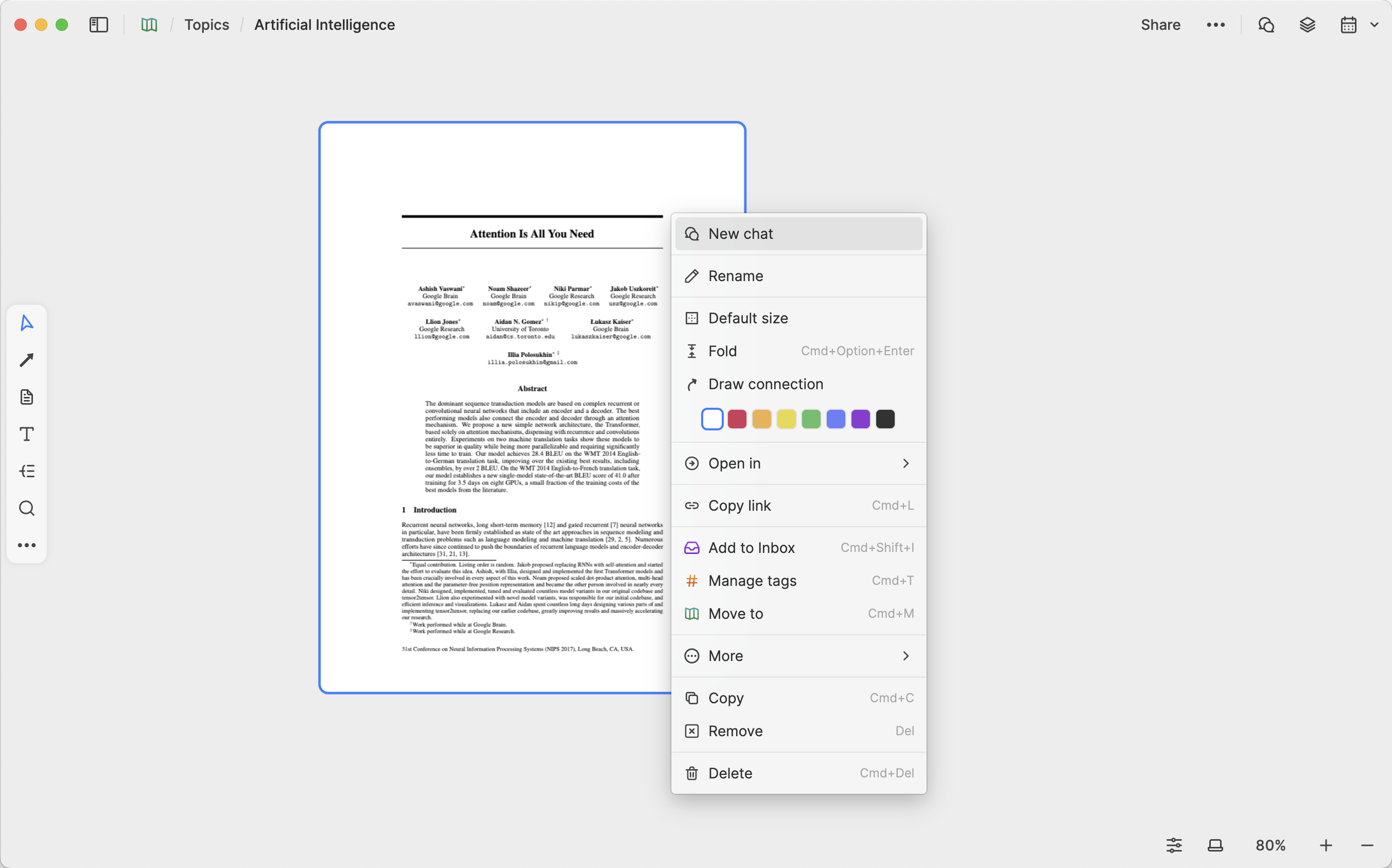
When chatting for the first time, Heptabase will automatically parse all text, tables, images, formulas, and other content in the PDF into a format suitable for AI to read, so some waiting time is required.
Once parsing is complete, you can specify page ranges when chat with AI based on this PDF. The specific method is as follows:
Confirm that the PDF has been added to the current AI chat context (currently not applicable to PDFs mentioned using @).
Click the PDF title above the chat box.
A range selection menu will appear; select the specified page range.
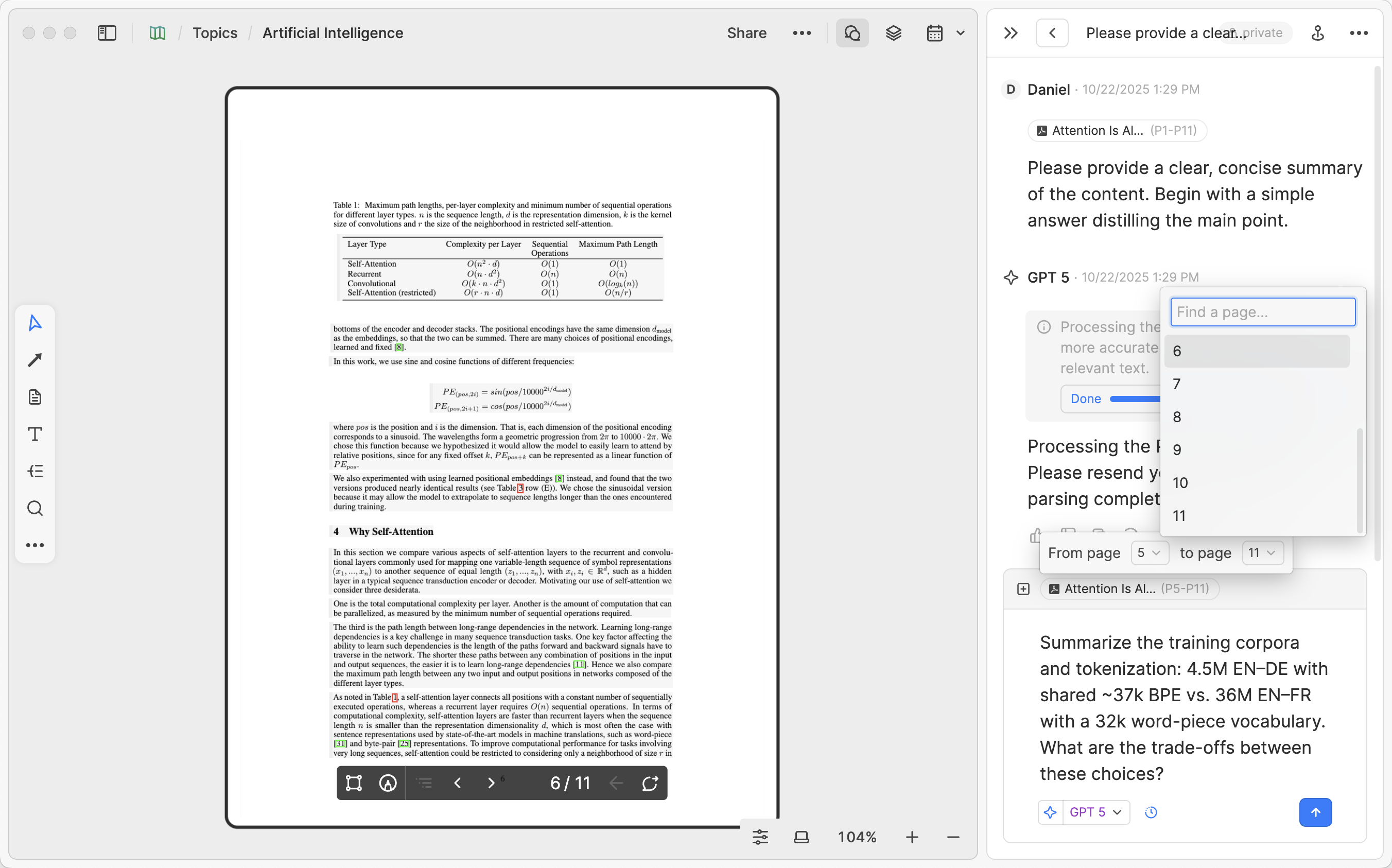
Besides, you can directly select the paragraph you want as context and provide it to AI. In the image below, I selected part of section 3.2, then added the content of that range to the conversation context through the button on the left.
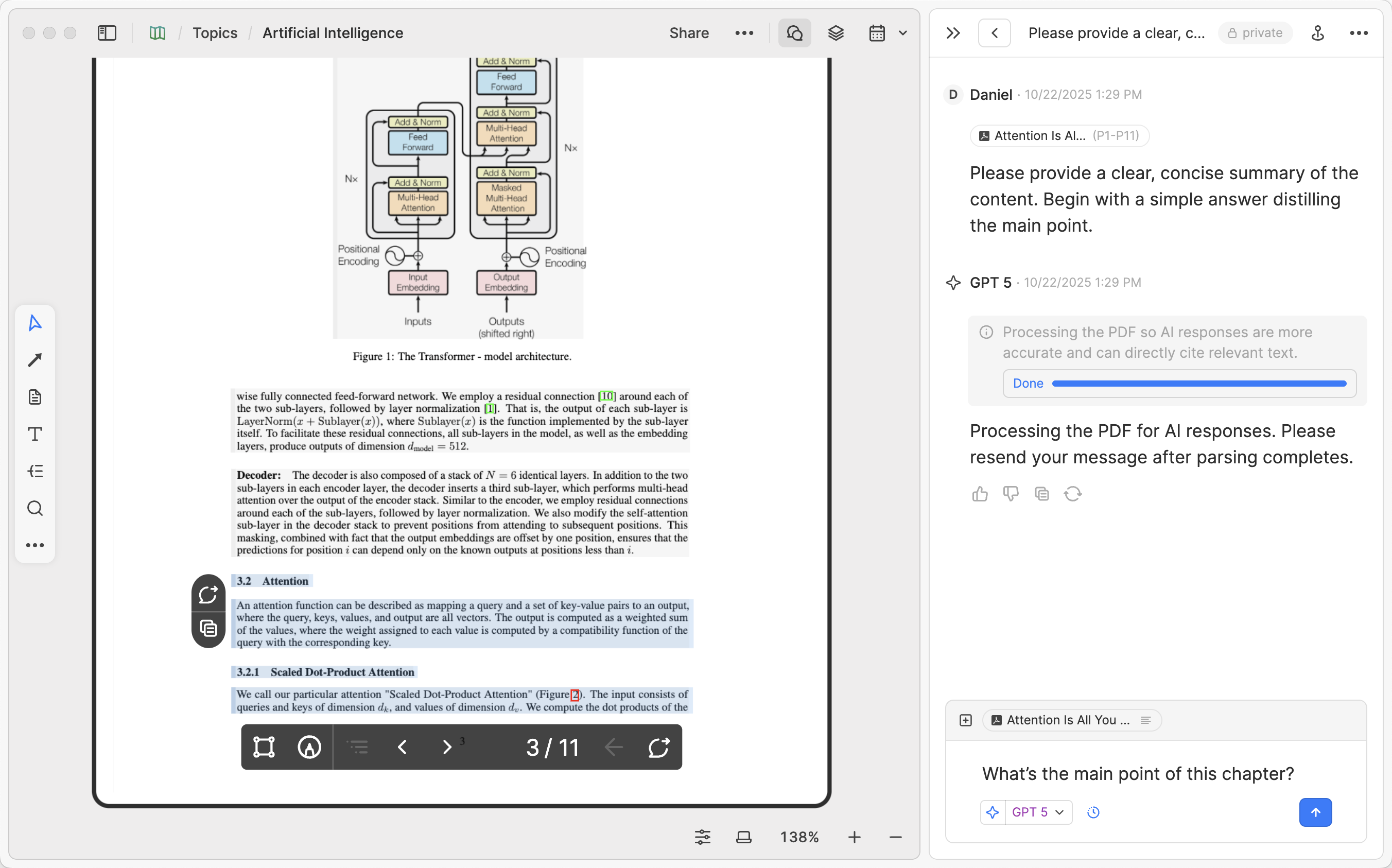
If you want to learn more about actual use cases for deep learning in Heptabase, you can read The Best Way to Use AI for Learning; if you want to know how to read and learn from different types of sources in Heptabase, please refer to Read PDFs, media, eBooks & webpages.
Chatting with Videos

If you prefer to learn or research through videos (for example: watching videos on specific topics and taking notes, attending online courses, reviewing replays of seminars and lectures), you can discuss specific videos with AI directly on the whiteboard. If this is a YouTube video, please follow these steps:
Copy the YouTube video URL you want to add.
Return to the whiteboard and paste the video using the shortcut (
Cmd/Ctrl + V).Right-click on the video and select New Chat to start chatting with AI.
This way, AI can respond based on the video content and attach timestamps to help you trace back to key segments at any time. Through this method, you can quickly transform key points scattered throughout a video into a digested knowledge structure.
Additionally, if the video you want to discuss with AI is not from YouTube, or if you have other types of learning materials like audio files or podcasts, you currently need to drag the file onto the whiteboard first and use Heptabase's speech-to-text feature to generate subtitles before you can chat with AI based on these files. For these operations, please read the Podcast section of Read PDFs, media, eBooks & webpages.
Chatting with Journals
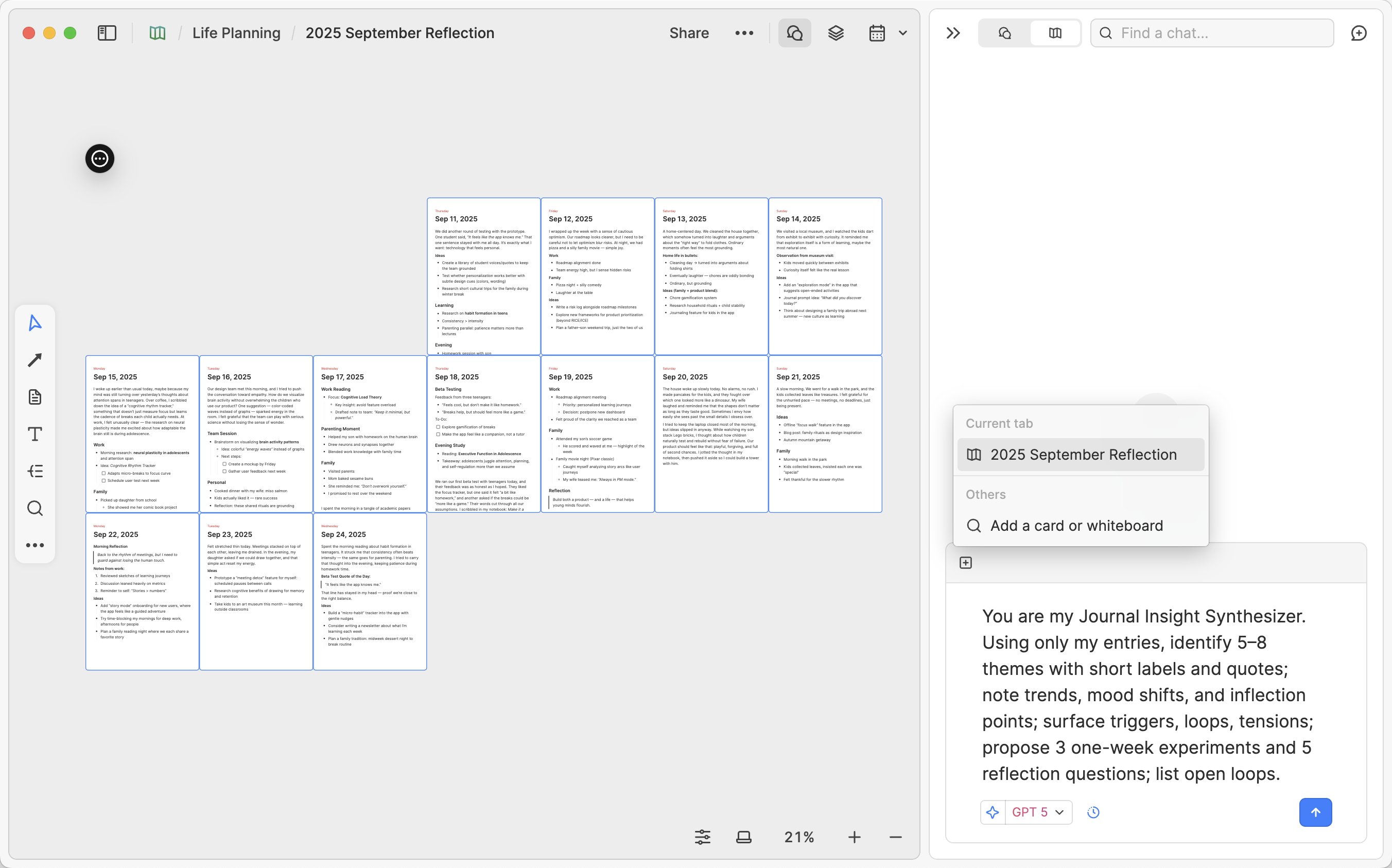
As you accumulate more and more content in your Heptabase Journal, you can discuss with AI based on journals from any date range. This is suitable for helping you identify recurring themes, improvement suggestions, and more, digging out unexpected insights from daily records!
Right-click in a blank area of the whiteboard and select Calendar, specifying to add all journals from a specific date range to the whiteboard.
Open Chat in the upper right corner of the whiteboard, click the add button and enter your question, allowing AI to read the entire whiteboard and respond based on your question.
AI's answers will directly locate specific content in the journals.
Chatting with Cards
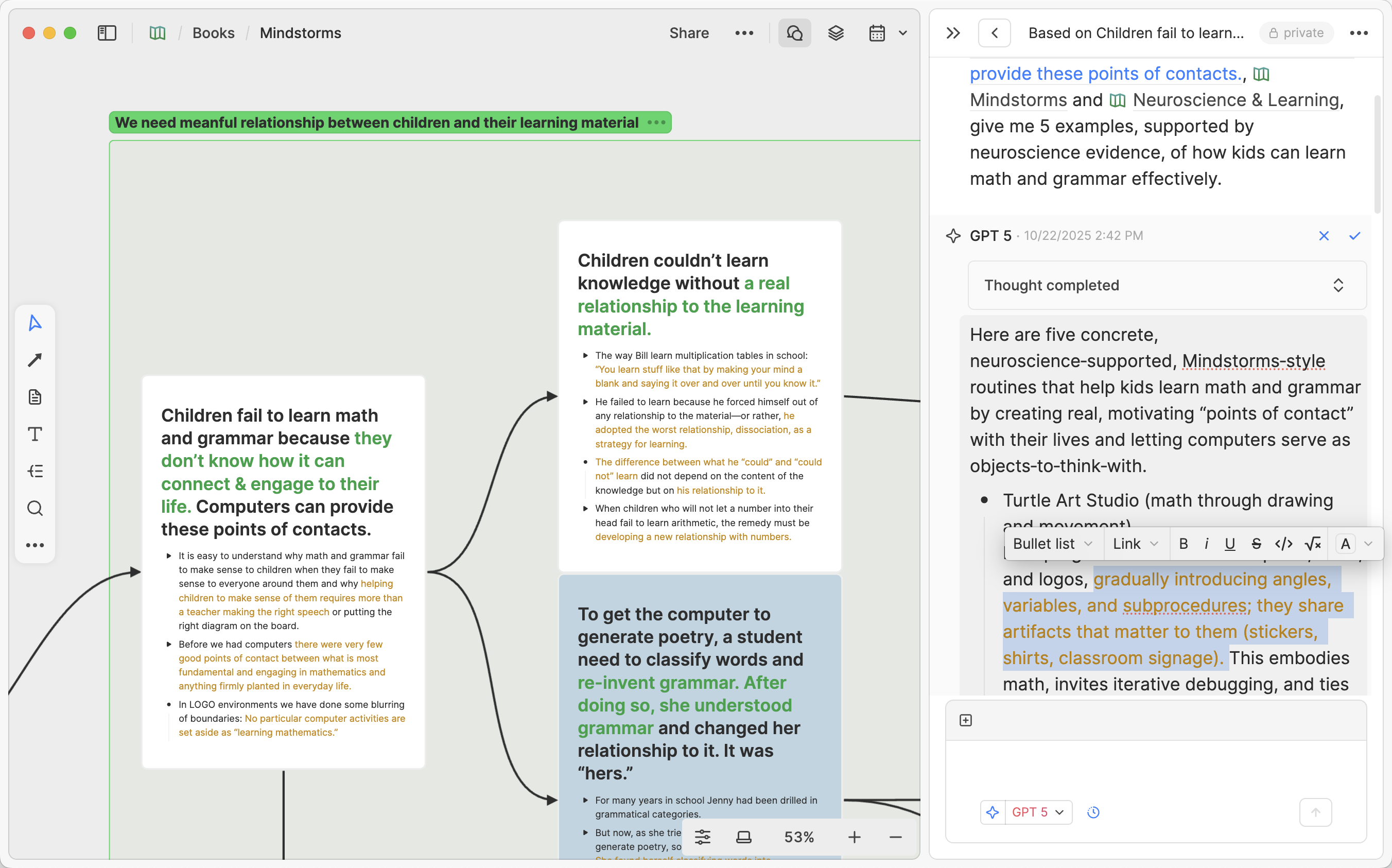
Of course, you can also discuss specific cards and paragraphs in Heptabase with AI. Here are several ways to chat with cards:
Select a card on the whiteboard, right-click and select New Chat.
Select text within a card and choose Add to Chat.
Mention specific cards using @ in your messages to AI, having AI answer your questions based on these cards' content.
When using Heptabase's AI chat feature, one of my favorite uses is to edit AI's reply messages, highlighting paragraphs I find important, adding some of my own annotations, and deleting information that's not useful to me. You can click the Edit button in the upper right corner of an AI's reply message to modify its content.
Upcoming Features
Heptabase's AI features are currently in public beta and require users to enter their own API Key to use. In the coming months, we will gradually provide free AI credits to Pro Plan users and offer more advanced AI plans for users who don't want to use API Keys. At the same time, we will also launch many advanced AI features, such as:
Allowing AI to answer questions based on your entire knowledge base and other MCP services;
Enabling AI to edit and manipulate cards and whiteboards according to your instructions;
Allowing other AI services (such as ChatGPT) to call and read/write Heptabase data through Heptabase's MCP Server;
…
Stay tuned!

本文重點
在 Heptabase 中,你可以在白板上開啟 Chat 與最新的 AI 模型進行對話,透過把卡片、Section、白板,或是 PDF、影片、日誌等內容添加到對話脈絡中,讓 AI 直接基於你選擇的內容進行回答。你也能將重要的訊息編輯與註解後放回白板中,和既有筆記一起視覺化整理、集中管理該主題的相關討論。透過與 AI 協作,將線性的對話記錄轉化為更完整知識結構,持續建立對知識主題的深入理解。
前言
在 AI 時代,人們會使用 ChatGPT、Google Gemini、Claude 這些最知名的 AI App 來學習和研究某個他們在乎的主題。然而:
當主題較複雜、涉及到許多不同觀念之間的聯繫時,你可能會希望能把 AI 所提供的知識重點從線性的對話串中拆解,放到一個大白板上便於研究與複習。
當你向 AI 提問時,你可能會希望 AI 能讀取你之前寫過的筆記或保存的知識內容,並且基於這些內容提供你有價值的回答。
這些正是 Heptabase 的 AI 功能擅長的事情。在這篇文章,我會帶你走過在 Heptabase 使用 AI 加速學習與研究的方法,並且針對不同類型的知識來源,分享常見的使用場景與工作流。
方法概述
一般來說,在 Heptabase 與 AI 協作通常包含以下幾個核心動作:
在主題白板中開啟 Chat,集中管理與該主題相關的對話。
以添加按鈕「+」或「@」提及,將白板與特定內容提供給 AI 作為脈絡。
將白板上的 PDF、影片、日誌、卡片右鍵添加到 Chat,並且基於這些來源進行對話。
將有價值的對話拖到白板或複製到卡片上進行編修、添加自己的註解。
以 Section、子白板或箭頭,逐步把 AI 協助產生的理解,整合進你的知識網絡中。
與白板對話

在 Heptabase,每個白板都代表著一個你在乎的主題。當你打開一個白板時,你可以點擊白板右上角的 Chat,查看與這個白板相關的對話。在每一則對話裡,你不僅可以跟這個白板的其他協作者對話,也可以開啟 AI 模式,跟來自 OpenAI、Google、Anthropic、xAI 等科技公司的最新 AI 模型們對話。
白板之於 AI 對話有三個主要用途:
思考工具:當你想要更好地梳理 AI 傳給你的訊息時,可以直接把你認為有價值的訊息拖到白板上視覺化。隨著累積的對話與訊息越來越多,你便能以這些訊息為基礎在白板上對該主題建立更深入、全面的理解。
主題式資料夾:你可以把與某個主題有關的 AI 對話集中放在同一個白板中,方便未來查找。
知識脈絡:你可以把整個白板添加到與 AI 對話的脈絡中,讓 AI 基於白板上的內容回答你問題。舉例來說,你可以一鍵把過去半年寫的所有日誌放到白板裡,請 AI 讀完後問它你所不知道的、跟你有關的事情,或是基於這些日誌給予你建議;或是把多個 PDF 檔與 YouTube 影片丟到白板上,讓 AI 以這些檔案和影片字幕的內容為基礎去回答你的問題。
具體來說,你可以按照下面步驟開始進行 AI 對話:
打開主題白板,點擊右上角 Chat,此時預設模式為 AI Chat。
在 Chat 中選擇 AI 模型和脈絡,輸入問題並開始對話。
將你認為有價值的訊息拖到白板上,並且基於這些資訊發展出更多對於該主題的理解。
提供脈絡給 AI:添加按鈕與「@」提及
添加脈絡是讓 AI 發揮最大價值的功能之一,下面兩種方法都能夠讓 AI 在回答你的問題前先讀取你指定的內容:
添加按鈕:點擊對話框左上角的「+」,你可以將特定卡片或是整個白板添加至對話脈絡中。

@ 提及:在訊息中輸入「@」,搜尋你希望作為脈絡的卡片、Section、白板並選取將其作為重點脈絡,這種方法適合快速尋找特定素材。

與 PDF 對話
如果你的學習與研究來源常是 PDF 檔案(例如:學術工作者做文獻回顧、產品經理閱讀產業報告、學生閱讀參考書),透過 Heptabase 的 PDF Parser 與 AI,你可以讓 AI 協助你理解 PDF 內容,甚至針對特定頁數、段落和 AI 進行討論,並將關鍵重點拆成卡片放到白板,同時保留頁碼與段落的可追溯性。
舉例來說,當你想要和 AI 針對 PDF 討論時,你可以:
直接把 PDF 拖到白板上。
對 PDF 右鍵,選擇 New Chat,與 AI 展開對話。

在第一次進行對話時,Heptabase 會先自動把 PDF 中的所有文字、表格、圖片、公式等內容全部解析成適合 AI 讀取的格式,因此會需要一些等待時間。
一旦解析完成,你未來跟 AI 基於這份 PDF 對話時可以指定頁數範圍,具體方法如下:
確認該 PDF 已經被添加至當前的 AI 對話脈絡中(目前不適用於使用 @ 提及的 PDF)。
點擊對話框上方的 PDF 標題。
此時系統會跳出一個選取範圍的選單,選取指定頁數範圍。

此外,你也可以直接圈選你希望作為脈絡的段落並提供給 AI,在下圖,我圈選了章節 3.2 的部分範圍,然後透過左側的按鈕將該範圍的內容添加至對話脈絡中。

如果你想了解更多在 Heptabase 深度學習的實際案例,你可以閱讀 The Best Way to Use AI for Learning;如果你想知道怎麼在 Heptabase 中針對不同來源的資料閱讀與學習,請參考 Read PDFs, media, eBooks & webpages。
與影片對話

如果你更偏好透過影片來學習或研究(例如:觀看特定主題的影片並寫下筆記、參加線上課程、複習研討會與講座的重播),你可以在白板中直接與 AI 針對指定的影片進行討論。如果這是一部 YouTube 影片,請參考以下做法:
複製你希望添加的 YouTube 影片網址。
回到白板,使用快捷鍵 (
Cmd/Ctrl + V) 貼上影片。對該影片右鍵並選擇 New Chat,與 AI 展開對話。
這樣一來,AI 便能夠針對影片內容進行回覆,並附上時間戳來幫助你隨時回溯到關鍵段落。透過這種方式,你可以快速將四散於影片中的重點轉變成消化過後的知識架構。
另外,如果你想和 AI 討論的影片並非來自於 YouTube,又或是你有其他像是音檔、Podcast 等類型的學習素材,現在你需要先將檔案拖曳到白板上,並透過 Heptabase 的音檔轉文字功能生成字幕後,才可以和 AI 以這類檔案為基礎進行對話。關於這部份的操作,請閱讀 Read PDFs, media, eBooks & webpages 的 Podcast 章節。
與日誌對話

當你在 Heptabase 日誌(Journal)累積越來越多的內容後,你可以基於任何日期範圍內的日誌和 AI 討論,它適合用來幫助你找出重複主題、改進建議等,從日常記錄中挖掘意料之外的洞見!
在白板空白處右鍵並選取 Calendar,指定把特定日期範圍的 Journal 全部丟到白板上。
到白板右上角開啟 Chat,點擊添加按鈕並輸入你的問題,讓 AI 讀取整個白板後根據你的問題進行回覆。
AI 的回答會直接定位到特定的 Journal 中的內容。
與卡片對話

當然,你也可以基於 Heptabase 中的特定卡片和段落與 AI 進行討論,以下是幾種可以與卡片對話的方式:
在白板上選取卡片,右鍵並選擇 New Chat。
選取卡片中的文字,選擇 Add to Chat。
在你傳給 AI 的訊息中用 @ 的方式去提及特定卡片,讓 AI 根據這些卡片的內容為基礎去回答你的問題。
在使用 Heptabase 的 AI 對話功能時,我很喜歡的一個用法是編輯 AI 回覆的訊息,把我認為重要的段落 Highlight 起來、添加一些我自己的註解,並把一些對我沒用的資訊刪掉。你可以點擊 AI 回覆訊息右上方的 Edit 按鈕來修改內容。
即將推出的功能
Heptabase 的 AI 功能目前處於公測階段,需要用戶輸入自己的 API Key 才能使用。在接下來幾個月,我們將逐步提供免費的 AI 額度給 Pro Plan 的用戶,並為那些不想使用 API Key 的用戶提供更進階的 AI 方案。同時,我們也將推出許多進階的 AI 功能,例如:
讓 AI 可以根據整個知識庫、其他 MCP 的服務回答問題;
讓 AI 有能力根據你的指令來編輯和操作卡片和白板;
讓其他 AI 服務(例如 ChatGPT)可以透過 Heptabase 的 MCP Server 調用和讀寫 Heptabase 的資料;
…
敬請期待!

本文の要点
Heptabase では、ホワイトボード上で Chat を開き、最新の AI モデルと対話することができます。カード、セクション、ホワイトボード、または PDF、動画、ジャーナルなどのコンテンツを対話の文脈に追加することで、AI に選択したコンテンツに基づいて直接回答させることができます。また、重要なメッセージを編集・注釈してホワイトボードに戻し、既存のノートと一緒に視覚的に整理し、そのトピックに関する関連ディスカッションを一元管理することもできます。AI との協働を通じて、線形の対話記録をより完全な知識構造に変換し、知識トピックへの深い理解を継続的に構築します。
序文
AI 時代において、人々は ChatGPT、Google Gemini、Claude などの著名な AI アプリを使用して、関心のあるトピックについて学習・研究しています。しかし:
トピックが複雑で、多くの異なる概念間の関連が含まれる場合、AI が提供する知識のポイントを線形の対話スレッドから抽出し、研究や復習をしやすくするために大きなホワイトボード上に配置したいと思うかもしれません。
AI に質問する際、以前書いたノートや保存した知識コンテンツを AI に読み取らせ、これらのコンテンツに基づいて価値ある回答を提供してほしいと思うかもしれません。
これらはまさに Heptabase の AI 機能が得意とすることです。この記事では、Heptabase で AI を使用して学習と研究を加速する方法をご案内し、さまざまなタイプの知識ソースに対して、一般的な使用シナリオとワークフローを共有します。
方法の概要
一般的に、Heptabase で AI と協働する際は、通常以下のコアアクションが含まれます:
トピックのホワイトボードでChatを開き、そのトピックに関連する対話を一元管理する。
追加ボタン「+」または「@」メンションを使用して、ホワイトボードと特定のコンテンツを AI に文脈として提供する。
ホワイトボード上の PDF、動画、ジャーナル、カードを右クリックしてChatに追加し、これらのソースに基づいて対話する。
価値ある対話をホワイトボードにドラッグするか、カードにコピーして編集し、自分の注釈を追加する。
セクション、サブホワイトボード、または矢印を使用して、AI 支援による理解を徐々に知識ネットワークに統合する。
ホワイトボードとの対話

Heptabase では、各ホワイトボードが関心のあるトピックを表しています。ホワイトボードを開くと、右上隅のChatをクリックして、このホワイトボードに関連する対話を表示できます。各対話では、このホワイトボードの他の協力者と対話できるだけでなく、AI モードを有効にして、OpenAI、Google、Anthropic、xAI などのテクノロジー企業の最新 AI モデルと対話することもできます。
ホワイトボードは AI 対話において 3 つの主な用途があります:
思考ツール:AI から受け取ったメッセージをより良く整理したい場合、価値があると思うメッセージを直接ホワイトボードにドラッグして視覚化できます。対話とメッセージが蓄積されるにつれて、これらのメッセージを基礎として、ホワイトボード上でそのトピックについてより深く包括的な理解を構築できます。
トピック別フォルダ:特定のトピックに関連する AI 対話を同じホワイトボードに集中させて、将来の検索を容易にできます。
知識の文脈:ホワイトボード全体を AI 対話の文脈に追加して、AI にホワイトボード上のコンテンツに基づいて質問に答えさせることができます。例えば、過去半年間に書いたすべてのジャーナルをワンクリックでホワイトボードに配置し、AI に読ませた後、自分について知らないことを尋ねたり、これらのジャーナルに基づいてアドバイスを求めたりできます。または、複数の PDF ファイルと YouTube 動画をホワイトボードに配置し、AI にこれらのファイルや動画の字幕のコンテンツに基づいて質問に答えさせることができます。
具体的には、以下の手順で AI 対話を開始できます:
トピックのホワイトボードを開き、右上隅のChatをクリックします。この時、デフォルトモードはAI Chatです。
Chat内で AI モデルと文脈を選択し、質問を入力して対話を開始します。
価値があると思うメッセージをホワイトボードにドラッグし、この情報に基づいてそのトピックについてより多くの理解を展開します。
AI に文脈を提供する:追加ボタンと「@」メンション
文脈を追加することは、AI が最大の価値を発揮できる機能の 1 つです。以下の 2 つの方法により、AI が質問に答える前に指定したコンテンツを読み取ることができます:
追加ボタン:対話ボックスの左上隅の「+」をクリックして、特定のカードまたはホワイトボード全体を対話の文脈に追加できます。

@メンション:メッセージ内で「@」を入力し、文脈としたいカード、セクション、ホワイトボードを検索して選択し、重要な参照として使用します。この方法は特定の素材を素早く見つけるのに適しています。

PDF との対話
学習や研究のソースが PDF ファイルである場合(例:学術研究者が文献レビューを行う、プロダクトマネージャーが業界レポートを読む、学生が参考書を読む)、Heptabase の PDF Parser と AI を通じて、AI に PDF コンテンツの理解を支援させ、特定のページや段落について AI と議論し、重要なポイントをカードに分解してホワイトボードに配置しながら、ページ番号と段落のトレーサビリティを維持できます。
例えば、PDF について AI と議論したい場合、以下のことができます:
PDF を直接ホワイトボードにドラッグします。
PDF を右クリックし、New Chatを選択して AI との対話を開始します。

最初の対話時、Heptabase は自動的に PDF 内のすべてのテキスト、表、画像、数式などのコンテンツを AI が読み取るのに適した形式に解析するため、待ち時間が必要です。
解析が完了すると、今後この PDF に基づいた AI 対話でページ範囲を指定できます。具体的な方法は以下の通りです:
PDF が現在の AI 対話の文脈に追加されていることを確認します(現在、@を使用してメンションした PDF には適用されません)。
対話ボックス上部の PDF タイトルをクリックします。
この時、範囲選択メニューがポップアップするので、指定したページ範囲を選択します。

さらに、文脈としたい段落を直接選択して AI に提供することもできます。下の画像では、セクション 3.2 の一部範囲を選択し、左側のボタンを通じてその範囲のコンテンツを対話の文脈に追加しています。

Heptabase での深い学習の実際のケースについてもっと知りたい場合は、The Best Way to Use AI for Learningを読むことができます。Heptabase でさまざまなソースのデータを読み取って学習する方法を知りたい場合は、Read PDFs, media, eBooks & webpagesを参照してください。
動画との対話

動画を通じて学習や研究することを好む場合(例:特定のトピックの動画を視聴してノートを取る、オンラインコースに参加する、セミナーや講演の再生を復習する)、ホワイトボード上で直接 AI と指定した動画について議論できます。これが YouTube 動画の場合は、以下の手順に従ってください:
追加したい YouTube 動画の URL をコピーします。
ホワイトボードに戻り、ショートカットキー(
Cmd/Ctrl + V)を使用して動画を貼り付けます。その動画を右クリックし、New Chatを選択して AI との対話を開始します。
このようにして、AI は動画のコンテンツに基づいて応答でき、タイムスタンプを付けて、いつでも重要なセグメントにトレースバックできるように支援します。この方法を通じて、動画全体に散らばった重要なポイントを消化された知識構造に素早く変換できます。
また、AI と議論したい動画が YouTube からのものでない場合、または音声ファイル、ポッドキャストなどの他のタイプの学習素材がある場合、現在はまずファイルをホワイトボードにドラッグし、Heptabase の音声からテキストへの機能を使用して字幕を生成した後でないと、AI とこのタイプのファイルに基づいて対話することはできません。この部分の操作については、Read PDFs, media, eBooks & webpagesの Podcast セクションをお読みください。
ジャーナルとの対話

Heptabase ジャーナル(Journal)にどんどんコンテンツが蓄積されていくと、任意の日付範囲内のジャーナルに基づいて AI と議論できます。これは繰り返しのテーマや改善提案などを見つけるのに適しており、日常の記録から予想外の洞察を掘り起こすことができます!
ホワイトボードの空白部分を右クリックし、Calendarを選択して、特定の日付範囲の Journal すべてをホワイトボードに配置することを指定します。
ホワイトボードの右上隅でChatを開き、追加ボタンをクリックして質問を入力し、AI にホワイトボード全体を読み取らせた後、質問に基づいて応答させます。
AI の回答は、Journal 内の特定のコンテンツに直接位置付けられます。
カードとの対話

もちろん、Heptabase 内の特定のカードや段落に基づいて AI と議論することもできます。以下は、カードと対話するいくつかの方法です:
ホワイトボード上でカードを選択し、右クリックしてNew Chatを選択します。
カード内のテキストを選択し、Add to Chatを選択します。
AI に送信するメッセージ内で@を使用して特定のカードをメンションし、AI にこれらのカードのコンテンツに基づいて質問に答えさせます。
Heptabase の AI 対話機能を使用する際、私が非常に気に入っている使い方の 1 つは、AI 返信メッセージを編集して、重要だと思う段落をハイライトし、自分の注釈を追加し、役に立たない情報を削除することです。AI 返信メッセージの右上隅にあるEditボタンをクリックして、コンテンツを変更できます。
今後リリース予定の機能
Heptabase の AI 機能は現在公開ベータ段階にあり、ユーザーは自分の API Key を入力する必要があります。今後数か月間で、Pro Plan ユーザーに無料の AI クレジットを段階的に提供し、API Key を使用したくないユーザーにより高度な AI プランを提供します。同時に、多くの高度な AI 機能もリリースする予定です。例えば:
AI が知識ベース全体や他の MCP サービスに基づいて質問に答えられるようにする
AI が指示に従ってカードやホワイトボードを編集・操作できるようにする
他の AI サービス(ChatGPT など)が Heptabase の MCP Server を通じて Heptabase データの呼び出しや読み書きができるようにする
…
ご期待ください!